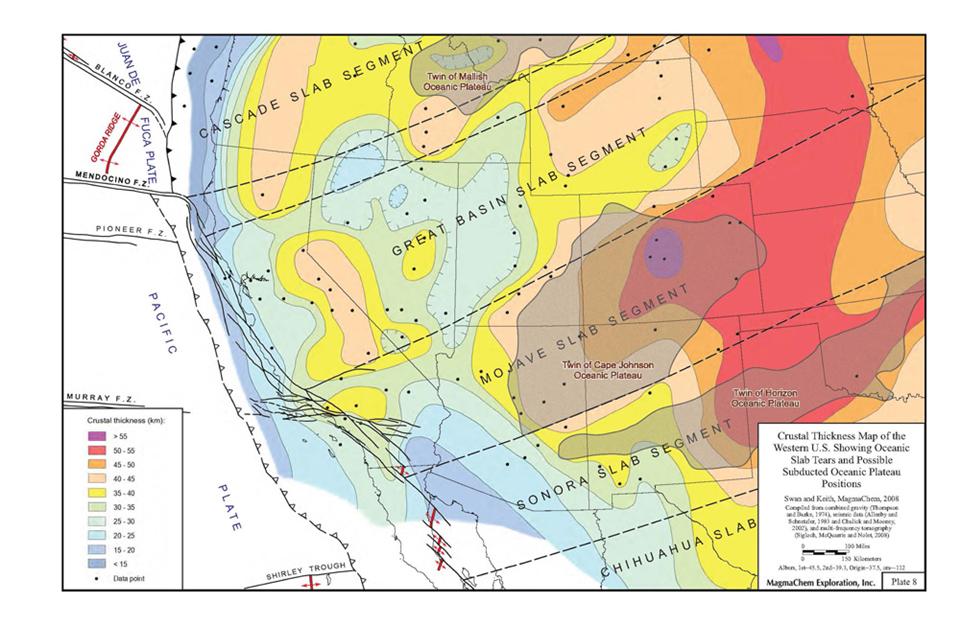Thinking about solutions at the nano-scale continues to be an area of opportunity for geoscientists, and it often requires new ways of thinking. Welcome to an interview with Monte Swan, whose experience in large-scale plate boundary research is complemented by his work in nano-scale environments where it is possible to find new ways to reduce the buildup of scale, paraffin, asphaltene, and more.
What is your name and your experience in the oil industry?
Monte Swan
- 1980-90 Applied our MagmaChem Petrotectonic Model for a Layered Earth and its plate tectonic implications to oil and gas. During that time, all major oil companies purchased our Sevier and Laramide Paleotectonic/Strato-Tectonic Study of the WUS
- 2000-present Conducted a $30 million research project with Exxon, Noble, BHP, and especially Statoil’s New Ideas Group and Det Norske R&D, focused on the overlooked first-order Earth process of serpentinization—see for an interesting perspective:
https://agu.confex.com/agu/fm16/preliminaryview.cgi/Session13254
What are some of the areas that you have focused on in the last 5-6 years?
In 2001 Exxon Research asked me, “When we do the accounting for super-giant oil & gas accumulations the books don’t balance. Do you have any idea what we are missing geodynamically and in our mass-balance calculations?” The process of sepentinization answers Exxon’s question and has now been documented with 200 case histories and 1.2 million chemical analyses funded primarily by Nobel, Statoil and Det Norske.

2014-Present, as Chief Scientist for Revelant and working with CSU through a research partnership, I’m focused on explaining how the downhole Enercat tool prevents paraffin crystallization, asphaltene flocculation, scale deposit and heavy oil increased viscosity up hole. This is not a mechanical, chemical or thermal tool. It is a nanofluidity technology that uses physics to drives chemistry and has been installed in thousands of wells in 22 countries and was first offered in the US only a month ago. The CSU research is critical to make this disruptive innovation a core technology in the oil & gas industry
Downhole Enercat tool that prevents paraffin crystallization, asphaltene flocculation, scale deposit and heavy oil increased viscosity up hole
What are some of your most compelling “lessons learned” ?
That science has become islands of conformity surrounded by interdisciplinary oceans of ignorance and that to discover we must sail the seas between the islands.
Which techniques, procedures, and new technologies have made the most difference?
Advancements in geochemical analytical techniques, aeromagnetics, gravity and statistical analysis of data. But most important is ‘reading’ inductively the story written in the rocks through ‘boots on the ground’ geologic mapping, which is now, in a sense, a ‘new’ technology, since it became a lost art with the institutionalization in science of reductionism. Integration of various disciplines in light of geologic story via mapping will make the most difference.
What do you see as the main challenges right now that could be impeding progress in developing new technologies or encountering “break-through” science?
Conceptual locks embraced by the scientific community. ‘Scientific revolutions are birthed one funeral at a time’. Lack of an innovation community for encouragement, support, and comradery makes it difficult for individuals—this is where most breakthroughs have occurred through history. Funding that allows pure science research—‘following the data where ever it leads’ is virtually impossible to find.
What do you do to think creatively? Do you have any special tactics?
Sustained period of hard, focused work is essential—then the discovery comes in the ‘bus, bath or bed’. For me the best breakthroughs come at 3:00 am when I’m half awake and both of my brain lobes are fully engaged, working together. Also during intense workshops and seminars where new data and ideas are shared. My daily hike through the mountains is especially good for creative thinking.
What are the technologies that seem to hold out the most promise in the near future?
Nano-scale is a frontier—the overlooked ‘mezo-scale between the well-studied macro and molecular scales. How thermal dynamics works at the nano-scale is not easily understood by thinking at the macro-scale. Nano-technologies are only now emerging and will tell us much about the macro. Also, anything to do with supercritical water (both nano-scale and non-ionic) has significant potential, especially when applied to geologic systems. I’m fascinated with the idea of constructing free-energy landscapes of geologic systems and processes such as serpentinization. But I must return to the lost art of geologic mapping and integrated geochemistry. Geologic relationships bring great insight into Earth processes. Tomography and 3-D high-resolution seismic (MRI of the Earth) only enhance these.
Can you recommend any books to read or listen to?
I have 7000 books in my home and office—don’t know where to begin. Oh . . . the rocks. They are the original 1st edition and the best book a geologist can read.
Thank you!
Don't Miss: AAPG Making Money with Mature Fields / October 5-6, 2017 / Houston, TX